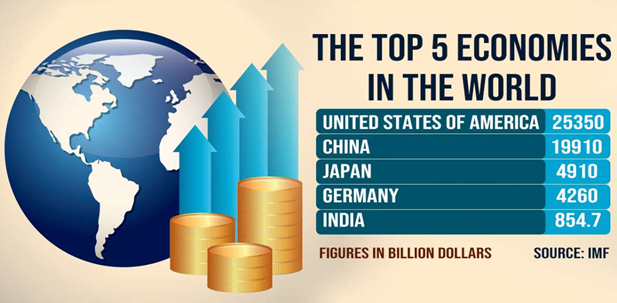

3rd September 2022 (6 Topics)
Context
India has leaped past the United Kingdom to become the fifth-largest economy in the world.
About
- India leaped past the UK in the final three months of 2021 to become the fifth-biggest economy.
- According to GDP figures from the International Monetary Fund, the calculation is based in US dollars, and India extended its lead in the first quarter.
- The Indian economy is forecast to grow more than 7% this year. A world-beating rebound in Indian stocks this quarter has just seen their weighting rise to the second spot in the MSCI Emerging Markets Index, trailing only China's.
- On an adjusted basis and using the dollar exchange rate on the last day of the relevant quarter, the size of the Indian economy in "nominal" cash terms in the quarter through March was $854.7 billion. On the same basis, UK was $816 billion.
- With the new development, India is only behind the US, China, Japan, and Germany, which as ranked as the largest, second-largest, third-largest, and fourth-largest economies in the world.
- The report comes two days after government data showed that India’s gross domestic product (GDP) rose 13.5 per cent in the June 2022 quarter (Q1FY23) as compared with the 20.1 per cent growth registered in Q1 2021-22.
- According to the latest data released by the National Statistical Office (NSO), during April-June 2022, the country’s gross value added (GVA), which is GDP minus net product taxes and reflects growth in supply, grew 12.7 per cent.

Economic Growth:
- Gross domestic product (GDP) is an estimate of the total value of finished goods and services produced within a country’s borders during a specified period, usually a year.
- GDP is popularly used to estimate the size of a country’s economy.
- GDP is most commonly measured by using the expenditure method, which calculates GDP by adding up spending on new consumer goods, new investment spending, government spending, and the value of net exports (exports minus imports).
|
Measuring GDP: Several popular ways to measure GDP, all of which are drawn from the World Bank database are described below:
|
More Articles

